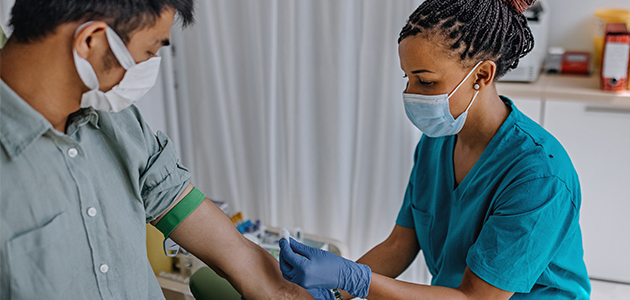Did you know that just one blood donation can potentially save up to three lives?
The average donation amount is three units of blood. In the United States 36,000 units are needed every day to help save the lives of people being treated for cancer, those involved in car accidents and natural disasters, those with an illness that causes anemia, and those who lose blood during surgeries.1 In the UK, 1.6 million units of blood are needed every year to meet patients’ needs—which requires 200,000 new donors annually to roll up their sleeves and donate.2
More than half of Canadians say they or a family member have needed blood or blood products—yet only 4% of Canadians actually donate blood.3 In fact, reluctance to donate blood is a common problem in all three countries, which is why National Blood Donor Month is the perfect time to encourage people to make an appointment to donate.
There are reasons why someone may be ineligible to donate blood, but most healthy adults can—and we all certainly have more than enough to spare to help save a life.
How do I know if I’m eligible to donate blood?
To find out if you are an eligible blood donor candidate visit Canadian Blood Services, American Red Cross, or Give Blood UK, depending upon where you live. You’ll find the eligibility requirements and donation appointment booking instructions on these sites.
What to expect during donation
Blood donation is virtually painless. If you’ve ever had an IV or been given a vaccination, that’s the amount of very brief discomfort you may experience when the donation procedure begins. After a quick medical examination where your blood pressure, pulse, temperature and hemoglobin levels will be checked, the donation will begin.
You will be reclined in a comfortable chair and have an IV inserted into your arm to collect the blood. The whole process takes about 10 minutes in total. After you’re finished, the needle is removed, a small bandage is put on the site, and you’ll move to a different area to rest for about 15 minutes. There you’ll be given a drink and a small snack as well as some instructions for aftercare before going on your way.
How long will it take for me to replace my own blood?
Within a few days, your body will have replaced the lost fluid, and after about two weeks you will have replaced the lost blood cells.4
Is it safe to donate?
As long as you have reviewed the eligibility requirements and know that you are in good health, blood donation is very safe. New, sterile equipment is used for each donor so there’s no risk of contracting a bloodborne infection when you donate blood.5
You may not give blood donation much thought until you or someone you love requires a transfusion, but there are patients who need blood every day to survive. The demand never stops. Donating blood is one of the most valuable gifts you can give—and it costs you nothing to do so.
This January, consider rolling up your sleeve and giving the gift of life.
SOURCES
3 https://myaccount.blood.ca/en/terme/faits
4, 5 https://www.mayoclinic.org/tests-procedures/blood-donation/about/pac-20385144
420338 CAN/US (01/22)




